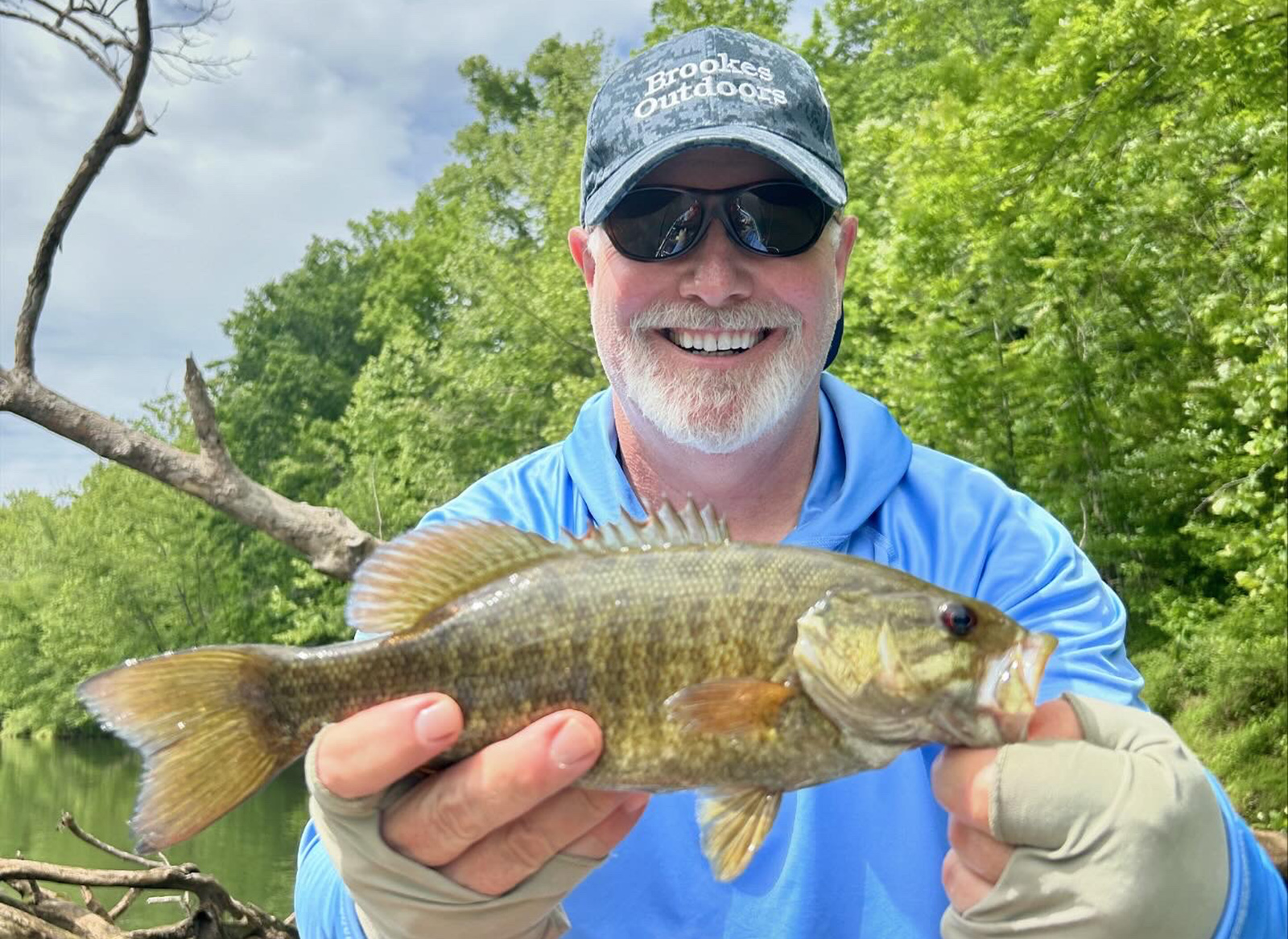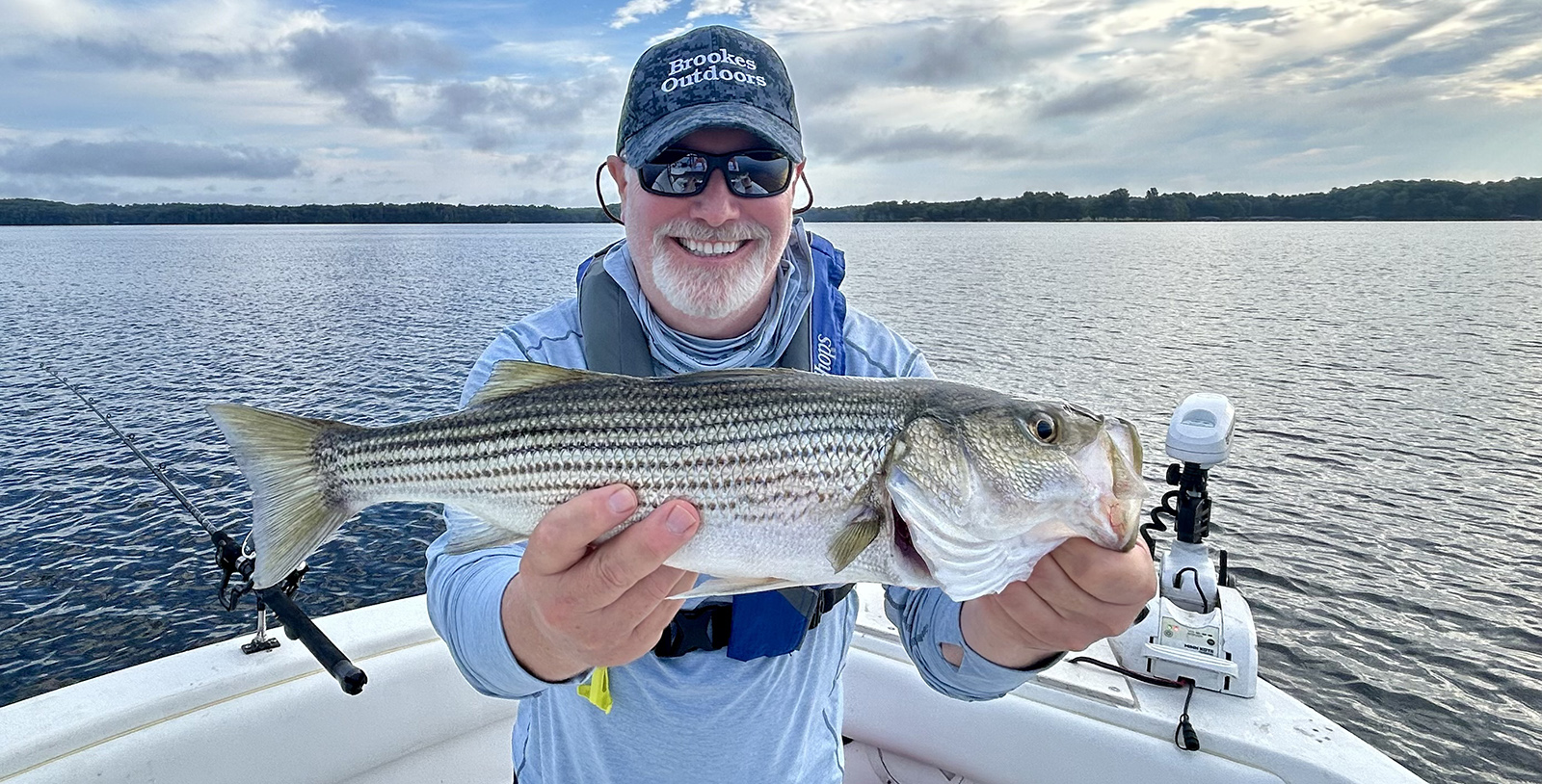By Dr. Peter Brookes
Photos by Dr. Peter Brookes
I’m always up for a challenge–within limits, of course. In other words, nothing illegal, immoral, unethical or anything involving the top of the Scoville scale (e.g., Carolina Reaper chili peppers).
With that in mind, I decided to take on the Virginia Department of Wildlife Resources’ (DWR) Virginia Bass Slam Challenge this spring/summer. It’s a natural follow-on to the Virginia Trout Slam Challenge, which I wrote about last fall.
The Bass Slam requires the angler to net three species of Virginia bass in a year. The eligible fish include the largemouth bass, smallmouth bass, striped bass, and/or a hybrid striped bass (a striper-white bass, which some call a “wiper”). Both wild and stocked fish of any size count toward the Slam.
While a full year is allotted for completing the Virginia Bass Slam Challenge, netting three bass species in one day in one water is considered the ultimate Bassapalooza. But it’s harder than you think. Indeed, I tried it this spring on the fly on the Staunton River. I landed a smallmouth and lost a largemouth, but never hooked a striper. My consolation prize was a good-sized walleye and a channel catfish, which is okay since they were firsts for me on the fly.
Thankfully, Virginia is an awesome bass fishery—certainly one of the best for smallmouth bass and trophy largemouth in the Central Atlantic. With tidal/non-tidal rivers, lakes, and reservoirs, opportunities abound for setting the hook on a Slam.
In addition to the Staunton, according to DWR, these Virginia waters hold at least three of the four species of bass included in the Challenge: Lake Anna, Rappahannock River, Smith Mountain Lake, Carvins Cove, James River, Claytor Lake, Flanagan Reservoir, and Hungry Mother Lake.
(For a list of pre-planned trips, check out this DWR page.)
After falling short on the Bassapalooza on the Staunton, I decided I was going to try to seal a Slam as quickly as possible, taking into account family and other day-to-day commitments I have. Let me tell you, the life of a part-time reel scholar isn’t easy…
As a gimme, I decided I’d give myself credit for the very nice smallies I’d caught on the fly on the Staunton River in late May. One bass species down and three to go with the clock running. Tick, tick, tick…

A smallmouth on the fly from the Staunton River kicked off the Bass Slam.
June was taken up with travel baseball tournaments for my son and trout fishing writing assignments in West Virginia, Idaho, (I know, I know, shame on me for fishing outside Virginia.) and on Virginia’s uber-fabulous Smith River, which I wrote about in July.
My next decent chance for bass was in early July, where I bagged a big largemouth in Potomac Creek on the fly rod, while chasing northern snakeheads. The snakes weren’t playing that day, but the bucket mouths thankfully were. Yes, it was a by-catch, but it still counts.

Ticked the largemouth off on Potomac Creek.
With two bass species down, I needed a striper or a wiper. Living in Northern Virginia, I planned a trip to nearby Lake Anna. We hit the water at the crack o’ dawn on an overcast day in late July; the lake surface was as smooth as glass.
A big weather front had passed the night before and fishing with live bait on conventional gear started slow. We were soon able to find some spots with lots of bait. Suddenly, the rod got arced deeply. “Yes!,” I thought, “I’ve done it!”
It wasn’t a striper….
Hard to believe, but I was disappointed in putting a 19-inch lunker in the net. I have to say: It’s so easy to get spoiled fishing for bass in the Old Dominion. Imagine being crushed, catching a nearly 20-inch largemouth bass?!
I was nervous: We were finding lots of bait balls, but not stripers. They’d clearly spread out. We moved around the lake a bit more in search of fish. In one spot, the rod showed signs of a soft take, not at all characteristic of a striper strike.
Something was definitely on the line, but what? Maybe it was a channel cat mouthing or stealing the bait? I began to reel up, assuming that the lack of fight was indicative of a smaller fish such as a saugeye (a sauger-walleye cross).
But when it breached the surface, it wasn’t some slam-busting saugeye—it was a 22-inch striper. Jackpot! I’m not sure why the good-sized fish wasn’t as feisty as I expected, but it, thankfully, sealed the Slam. Perhaps, the fishing gods, aware of my perilous piscatorial plight, were graciously conspiring in my favor for once?

A Lake Anna striped bass sealed the Bass Slam deal.
Anyway, I’d accomplished the Slam in three outings over about two months using both fly fishing and conventional gear. I was totally chuffed, but I still want to catch a wiper, use all fly gear for the Slam, and get a Slam all in one day.
I doubt I’ll get to these new, self-imposed bass and Bass Slam challenges this summer. But with it only being the beginning of August, you certainly can give it a go; bass fishing should be prime out into September. So, don’t delay: Get your gear, get your Virginia license if you don’t have one, and go get a Bass Slam.
Take pictures of your catches and register the Slam with DWR for a really cool Bass Slam sticker. I’ve already ordered mine and have a good spot picked out for it on my beat-up, over-stickered, hunting/fishing Jeep.
And when you get your Slam, don’t forget to share photos of your angling acumen with the rest of us on social media. (Like I had to tell you that?!) Tag your post with @VirginiaWildlife and #VABassSlam.
Dr. Peter Brookes is a Virginia-based, award-winning outdoor writer. He’s got his eye on the unofficial “Dino-Slam” next, putting a Virginia gar, bowfin, and snakehead in the boat. Brookesoutdoors@aol.com


